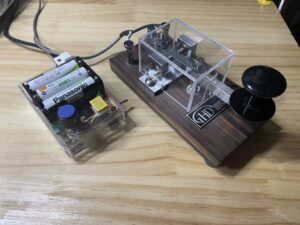I’m an amateur radio operator, and I mostly use telegraphy, so I can’t limit this idea to smartphones.
But, I’m embarrassed to say that despite all this experience and having built many radios and peripherals, I’m practically ignorant when it comes to designing electronic circuits. I simply build or combine circuits published in magazines, assembling them with a soldering iron in hand…I hardly use my brain at all.
This time, I’m planning to combine existing common circuits to create something that will produce a low-frequency vibration when a Morse code is input from the speaker output of a radio.

Of these, the “rectifier circuit + switching circuit” is called a “VOX circuit” in the radio world, and there are some that automatically turn on the transmission switch when you speak into the microphone, so they are all basically standard electronic circuits. I thought it would be easy if I combined the reference circuits on the device manufacturer’s datasheet, so I started making one, despite not having much knowledge. As expected, my lack of knowledge was revealed when I got to the transistor switching circuit, which had no datasheet. (sigh)

Well, this circuit does work somehow, so I’ll call it a good thing. If anyone is knowledgeable about electronic circuits and notices any points that should be corrected, please let me know. The power supply voltage is 3.6V for three NiMH batteries (4.5V for three AA batteries as well). Using three AA batteries will cause the linear actuator to overheat (though not enough to burn you), so two batteries with 3V might be better. Masking tape has been applied to the surface of the element as a mitigating measure.

But how can a visually impaired person tell the difference between a NiMH AA battery and an alkaline AA battery? Since starting this project, I have become more aware of the concept of universal design in many places.